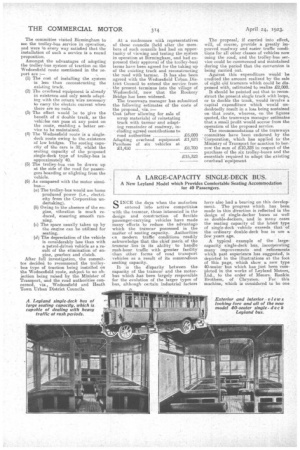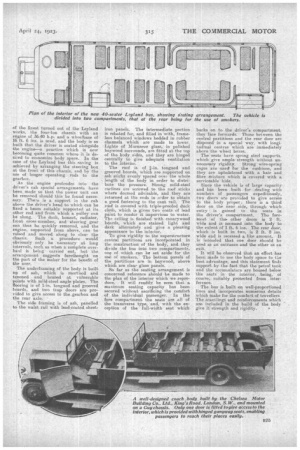A LARGE-CAPACITY SINGLE-DECK BUS.
Page 22

Page 23

If you've noticed an error in this article please click here to report it so we can fix it.
A New Leyland Model which Provides Comfortable Seating Accommodation for 40 Passengers.
SINCE the ,day's when the moterbes entered into active competiticse with the tramcar, those interested in the design and construction of flexible passenger-carrying vehicles have made many efforts to reduce the advantage which the tramcar possessed in the matter of seating capacity. Authorities en modern traffic conditions readily acknowledge that the chief merit of the tramcar lies in its ability to handle rush-hour traffic with greater facility than other forms of road transport vehicles as a result of its commodious seating capacity.
It is the disparity between the capacity of the tramcar and the motorbus which has been largely responsible for the evolution of the larger types of bus, although certain industrial factors have also had a bearing on this developmeat. The progress which has been made in this, direction is reflected in the design of single-decker buses as well as double-deckers, and in many cases the seating capacity of the latest type of single-deck vehicle exceeds that of the ordinary double-deck bus in use a few years ago.
A typical example of the largecapacity singlezdeek bus, incorporating manyimprovements and refinements which past experience has suggested, is depieted in the illustrations at the font of this page, which show a new type 90-seater bus which has just been completed in the works Of Leyland Motors, Ltd., to the order of Messrs. Rankin Brothers, of Chryston. For this machine, which is considered to be one of the finest turned out of the Leyland works, the four-ton chassis with an engine of 36-40 h.p. and a wheelbase of 16 ft.. 6 ins. is used, and the body is so built that the driver is seated alongside the engine—a practice which is now becoming quite common where it is desired to economize body space. In the case of the Leyland bus this saving is achieved by arranging the steering box at the front of this chassis, and by the use of longer operating rods to the gearbox.
As the engine protrudes into the driver's cab special arrangements have been made so that the Dower unit can be removed should this be found necessary. There is a support M the cab above the driver's head to which can be fixed a beam suitably supported at its other end and from which a pulley can be slung. The dash, bonnet, radiator, front cross-member, and steering gear can thus be quickly removed, tall the engine, supported from above, can be raised and moved along to clear the chassis. Such a procedure would obviously only be necessary at long intervals, such as when a complete overhaul is being carried out, but the • arrangement" suggests forethought on the part of the maker for the benefit of the user.
The underframing of the body is built up of ash, which is iriortsed and tenoned and brazed at vulnerable points with mild-steel angle plates. The flooring is of 1-in. tongued and grooved boards, and two trap doors are provided to give access to the gearbox and the rear axle.
The side framing is of ash, panelled to the waist rail with leattcoated sheet iron panels. The intermediate portion is rebated for, and filled in with, frameless balanced windows bedded in rubber channels which are made to lower.. Lights of Muraneze glass, in polished haywood surrounds, are fitted at the top of the body &des, and they are hinged centrally to give adequate ventilation to the interior.
The roof is of /-in. tongued and grooved boards, which are supported on ash stieks evenly 'spaced over the whole length of the body in order to distri:. bute the pressure. Strong mild-steel cortines are screwed to the roof sticks where deemed advisable, and they are returned at the ends in order to obtain a good fastening to the cant rail. The roof is covered with triple-proofed duck cloth, which is given two coats of lead paint to render it impervious to water. The ceiling is finished with canarywood boards, which are stained light and dark alternately and give a pleasing appearance to the interior. To give rigidity to the superstructure central partitions are incorporated in the construction of the body, and they divide the bus into two compartments, one of which can be set aside for the use of smokers. The bottom panels of the partitions are in baywood, above which are clear glass panels.
So far as the seating arrangement is concerned reference should be Made to the plan of the interior which we reproduce. It will readily be seen that a maximum seating capacity has been secured without sacrificing the comfort of the individual. passenger. In the fore compartment the seatz are all of the transverse type, and, with the exception of the full-width seat which
backs on to the driver's compartment, they face forwards. Those between the central partitions and the rear door are disposed in a special way, with longitudinal centres which are iminediately above the wheel boxes.
The seats have spring steel supports, which give ample strength without unnecessary rigidity. Strong wire-spring cages are used for the cushions, and they are upholstered with a hair and fibre mixture which is covered with a serviceable hide.
Since the vehicle is of large capacity and has been built for dealing with numbers of passengers expeditiously, two doors are provided to give access to the body proper; there is a third door on the near side, through which entry is gained to the seats in the driver's compartment. The foremost of the.. other doors is 2 ft. wide and is recessed into the body to the extent of 1 ft. 6 ins. The rear door, which is built in two, is 2 ft. 8 ins. wide and is recessed a like amount. It. is intended that one door should beused as an entrance and the other as an exit.
It will be observed that an effort has been Made to use the bodyspace to tie best advantage, and this statement finds support by the fact that the petrol tank and the accumulators are housed below the seats in the interior, being, of course, suitably protected from interference.
The bus is built on well-proportioned lines and incorporates numerous details which make for the comfort of travellers The sta.ntlings and reinforcements which are included in the build of the body give it strength and rigidity. •






























